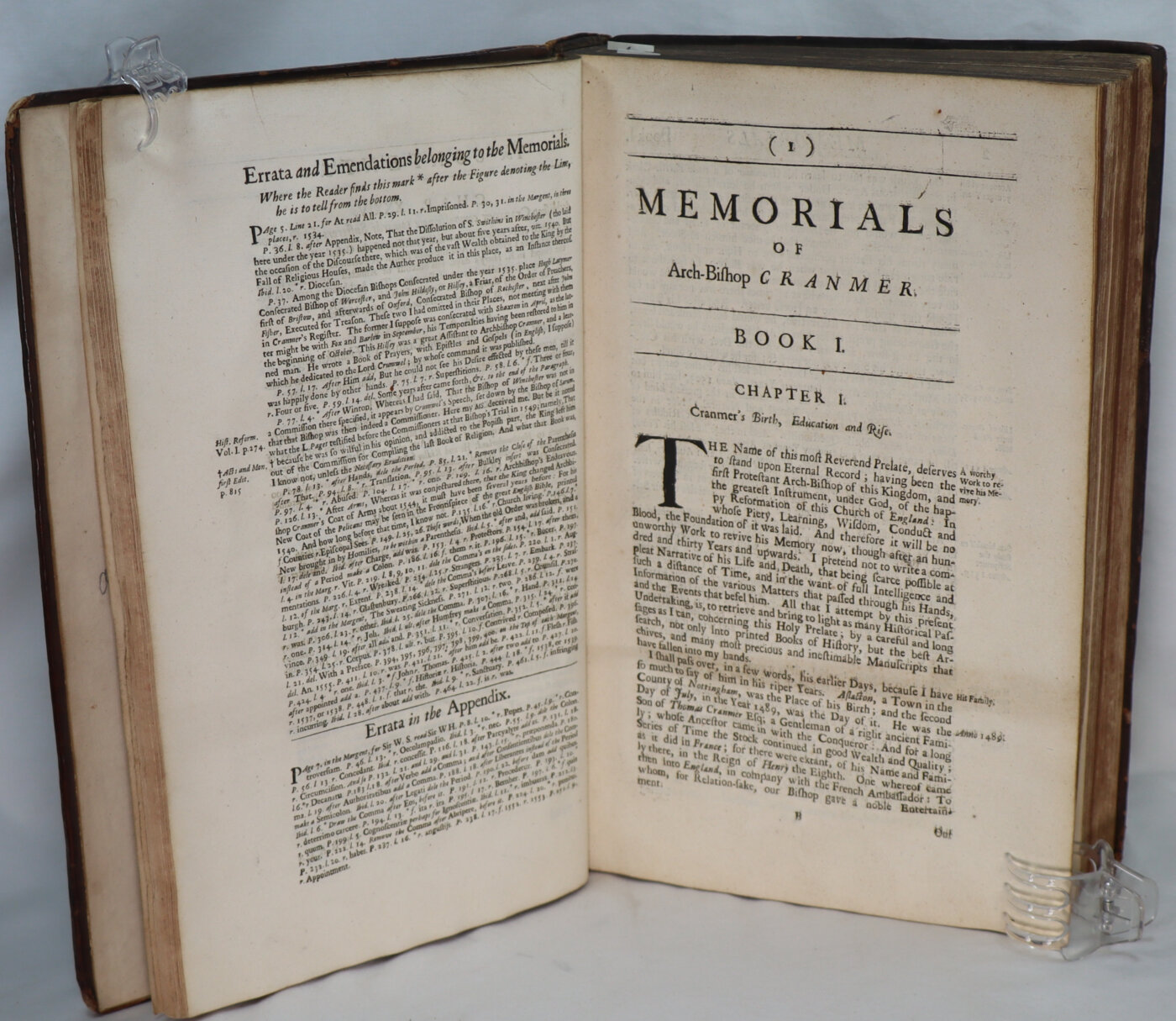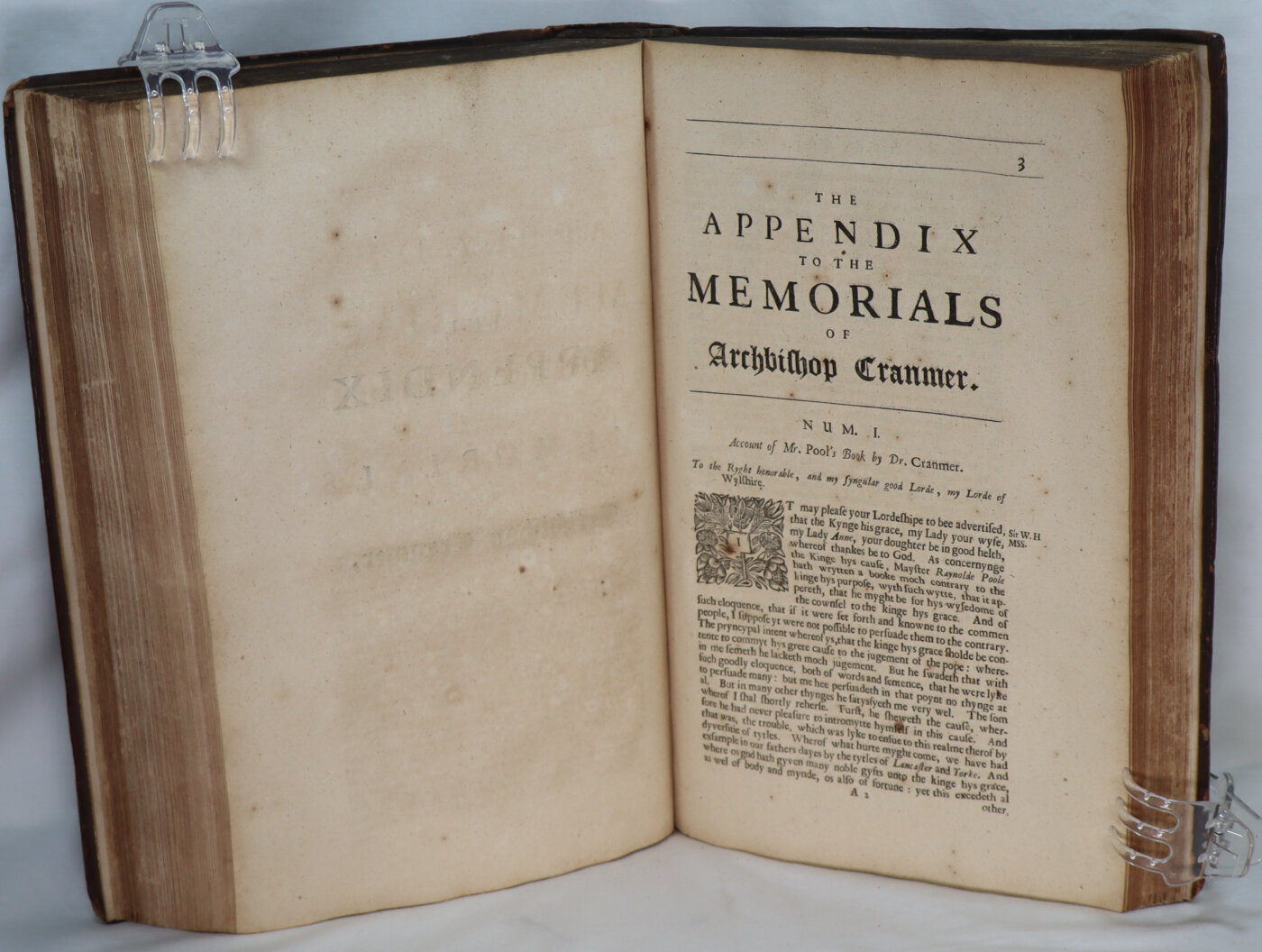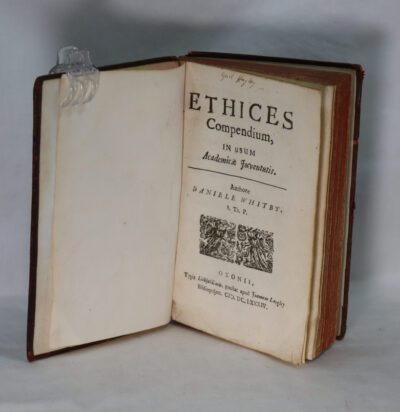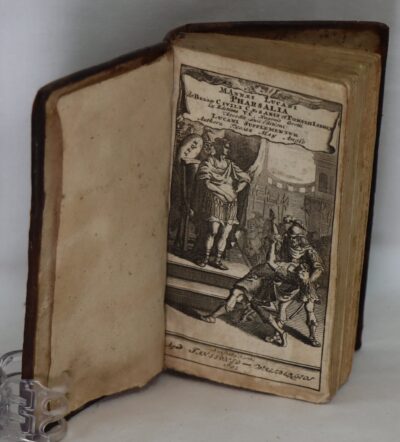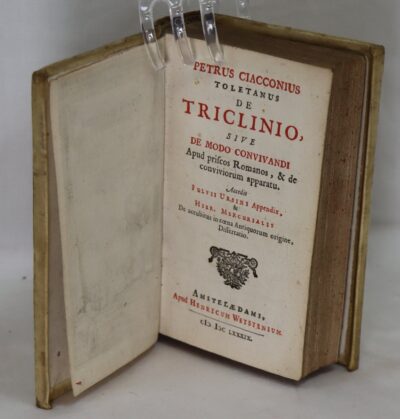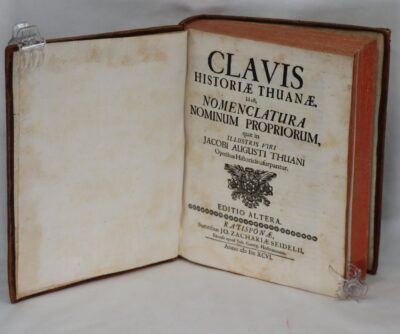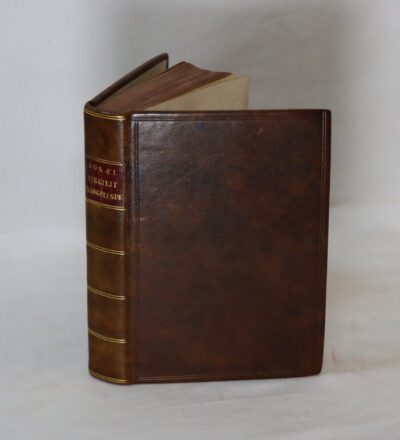Strype's Memorials of Cranmer.
By John Strype
Printed: 1694
Publisher: Richard Chiswell. St Pauls Churchyard, London
| Dimensions | 22 × 32 × 6 cm |
|---|---|
| Language |
Language: English
Size (cminches): 22 x 32 x 6
Condition: Fine (See explanation of ratings)
FREE shipping
Your items
Item information
Description
Brown leather binding with raised banding, black title plate and gilt title on the spine.
-
We provide an in-depth photographic presentation of this item to stimulate your feeling and touch. More traditional book descriptions are immediately available.
-
Note: This book carries the £5.00 discount to those that subscribe to the F.B.A. mailing list.
Book Description ‘Memorials of the most Reverend Father in God, Thomas Cranmer, sometime Lord Archbishop of Canterbury. Wherein the history of the Church, and the reformation of it, during the primacy of the said archbishop, are greatly illustrated; and many singular matters relating thereunto, now first published. In three books. Collected chiefly from records, registers, authentic letters, and other original manuscripts. By John Strype, M.A.’
Hardcover. Condition: Near Fine. First edition. Folio volume now bound in leather. The frontispiece is an image of Cranmer executed by Holbein. The remaining 5 portraits are those of Peter Martyr Vermilius, John A’Lasco, Martin Bucer, Hugh Latimer, and Philip Melancthon.
Strype was a very prolific writer with well over a dozen works published. This is his third work, published when he was 46. He lived to be 95. This volume is a remarkably clean, bright and solid example. A lovely book in all respects and an important work of 16th century English historical scholarship. Near Fine.
Thomas Cranmer (2 July 1489 – 21 March 1556) was a religious figure who was leader of the English Reformation and Archbishop of Canterbury during the reigns of Henry VIII, Edward VI and, for a short time, Mary I. He helped build the case for the annulment of Henry’s marriage to Catherine of Aragon, which was one of the causes of the separation of the English Church from union with the Holy See. Along with Thomas Cromwell, he supported the principle of royal supremacy, in which the king was considered sovereign over the Church within his realm.
During Cranmer’s tenure as Archbishop of Canterbury, he established the first doctrinal and liturgical structures of the reformed Church of England. Under Henry’s rule, Cranmer did not make many radical changes in the Church due to power struggles between religious conservatives and reformers. He published the first officially authorised vernacular service, the Exhortation and Litany.
When Edward came to the throne, Cranmer was able to promote major reforms. He wrote and compiled the first two editions of the Book of Common Prayer, a complete liturgy for the English Church. With the assistance of several Continental reformers to whom he gave refuge, he changed doctrine or discipline in areas such as the Eucharist, clerical celibacy, the role of images in places of worship, and the veneration of saints. Cranmer promulgated the new doctrines through the prayer book, the Homilies and other publications.
After the accession of the Catholic Mary I, Cranmer was put on trial for treason and heresy. Imprisoned for over two years and under pressure from Church authorities, he made several recantations and reconciled himself with the Catholic Church. While this would have customarily absolved him, Mary wanted him executed, and he was burned at the stake on 21 March 1556; on the day of his execution, he withdrew his recantations, to die a heretic to Catholics and a martyr for the principles of the English Reformation. Cranmer’s death was immortalised in Foxe’s Book of Martyrs and his legacy lives on within the Church of England through the Book of Common Prayer and the Thirty-Nine Articles, an Anglican statement of faith derived from his work.
John Strype (1 November 1643 – 11 December 1737) was an English clergyman, historian and biographer from London. He became a merchant when settling in Petticoat Lane. In his twenties, he became perpetual curate of Theydon Bois, Essex and later became curate of Leyton; this allowed him direct correspondence with several highly notable ecclesiastical figures of his time. He wrote extensively in his later years.
Born in Houndsditch, London, he was the son of John Strype (or van Stryp) and cousin to sailor and writer Robert Knox. A member of a Huguenot family who, in order to escape religious persecution within Brabant, had settled in East London. Located in what has now become known as Strype Street in Petticoat Lane, he was a merchant and silk throwster. The younger John was educated at St Paul’s School, and on 5 July 1662 entered Jesus College, Cambridge; he went on from there to St Catharine’s Hall, where he graduated B.A. in 1665 and M.A. in 1669.
On 14 July 1669 Strype became perpetual curate of Theydon Bois, and a few months afterwards curate and lecturer of Leyton in the same county. He was never instituted or inducted to the living of St Mary’s Church, Leyton, but in 1674 he was licensed by the Bishop of London to preach and expound the word of God, and to perform the office of priest and curate while it was vacant, and until his death he received the profits of it. In 1711 he obtained from Archbishop Thomas Tenison the sinecure of West Tarring, Sussex, and he discharged the duties of lecturer at Hackney from 1689 until 1724. In Hackney, he spent his last years with a married granddaughter, the wife of a surgeon, Thomas Harris, dying there at the age of 94. He was buried in the church at Leyton.
Through his friendship with Sir William Hicks, Strype obtained access to the papers of Sir Michael Hicks, secretary to Lord Burghley, from which he made extensive transcripts; he also carried on an extensive correspondence with Archbishop William Wake and Bishops Gilbert Burnet, Francis Atterbury and Nicholson. The materials he obtained were used in his historical and biographical works, which relate chiefly to the period of the Protestant Reformation. Most of his original materials have been preserved, and are included among the Lansdowne manuscripts in the British Library. His publications consist of historical reference material of considerable value, and are convenient books of reference.
Want to know more about this item?

Share this Page with a friend




